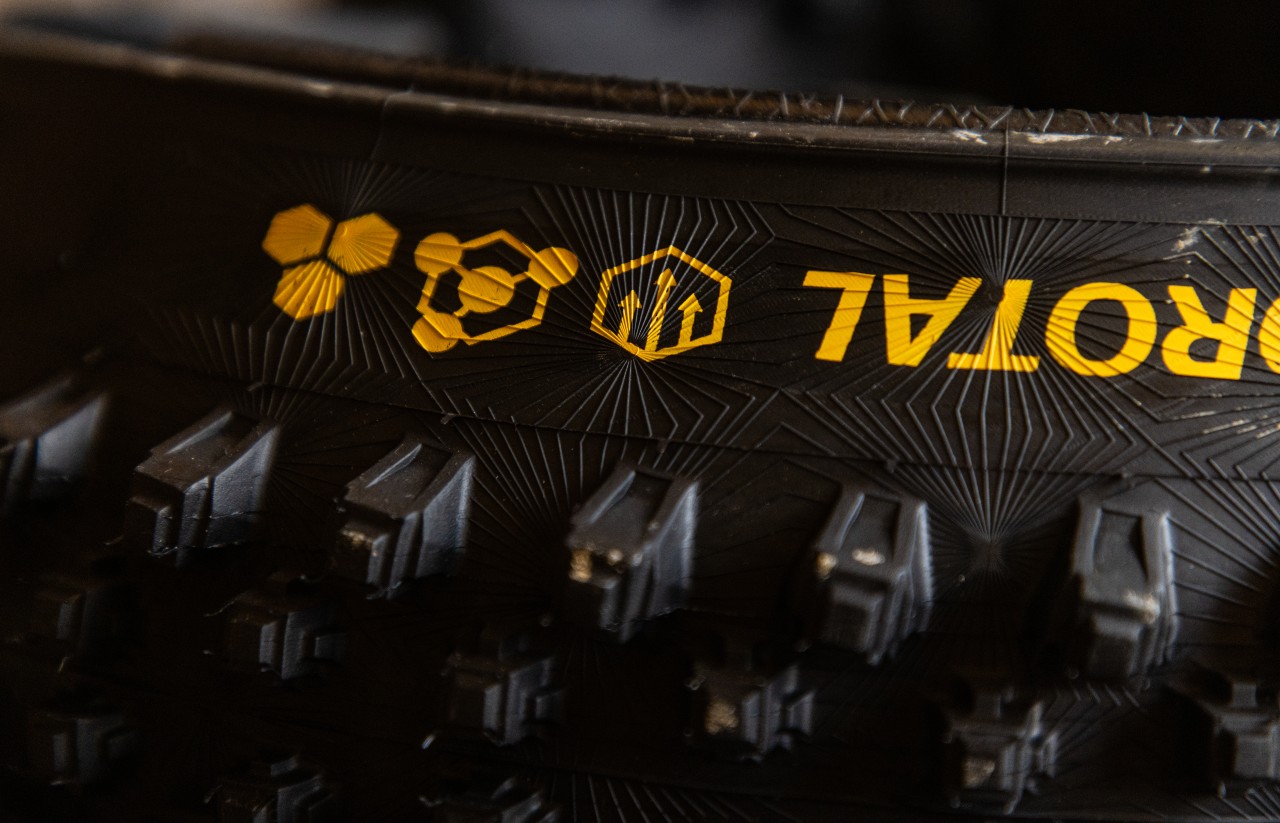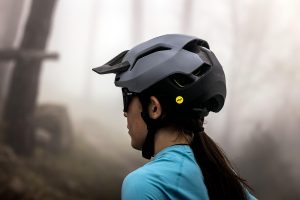The tyre manufacturer drop an entire range of tyres in one go, with a total of five different treads spread over four different models. We put the Kryptotal to the test at Dyfi bike park.
Continental Kryptotal gravity downhill tyre first ride review
Continental has just released a whole new range of Gravity tyres designed to suit downhill and enduro riders, with multiple casing, compound and tread options. Developed with the input of pro-riders from Atherton Racing, Nukeproof and Pivot teams, they promise better braking, surer placement, fewer flats and lighter weight, the magic qualities that may elevate them to among the best mountain bike tyres on the market if the claims bear out.
I got to ride some of the new models at Dyfi Bike Park alongside the professional riders that helped develop them. The first impressions here are just that, since I’ve only ridden the tyres at one location. But with new tyres incoming, expect full reviews of multiple models in MBR in the coming months.

Need to know:
- Four models designed to suit dry, wet, loose and mixed terrain
- Downhill, enduro and trail casings
- Three compounds: Supersoft, Soft and Endurance
From what World Cup-level test riders like Gee Atherton and Bernard Kerr and the German tyre boffins over from Germany explained, it’s clear Conti has gone all in on this relaunch and is committed to making a big splash in the more aggressive end of the MTB tyre market.
Prototyping, blind testing and pro input
This whole Gravity project started in late 2018 and has taken three years and dozens of prototypes and revisions to reach this point. Testing took the form of ‘blind’ back-to-backing, with much mileage at Atherton HQ at Dyfi Bike Park, with the lead German engineer constantly probing rider expectations by changing compound blends and carcass designs to challenge preconceptions about exactly how each element of the tyre build ‘matrix’ interacts with each other.

The result? Continental feels that it’s overturned the assumption (by its own admission) that it was lacking products people needed in every area for several seasons, so launched an entire range at once. It’s a bold move and something I don’t remember another tyre brand doing before.
Continental Gravity tyre range overview

A total of five different treads spread over four different models are available; the Kryptotal, Xynotal, Argotal and Hydrotal. DH, enduro and trail casings options, plus the Supersoft, Soft and Endurance compound options on top of this make for a wide array of tyre choices to suit pretty much every gravity rider’s desired terrain and condition setup.

The Continental Xynotal mountain bike tyre
The Xynotal is designed for dry conditions, hardpack ground and rocky trails with a tread patter with angled in-line shoulder studs.
The Kryptotal, the tyre I tested at Dyfi Bike Park, is the mixed terrain option in the range and has a tread pattern designed to offer the required performance over varying surfaces.

The Continental Argotal gravity mountain bike tyre
Argotal has in-line shoulder studs and a supportive structure to offer stability and grip on loose terrain, the conditions niche this model has been designed for.

The Continental Argotal gravity mountain bike tyre
Finally, as the name suggests the Hydrotal is the wet weather tyre with an open tread pattern, in-line shoulder studs, tapered and supported stud elements to offer maximum grip for aggressive riding in sloppy, slippy, muddy conditions.
Prices start at £59.95 / €59.95.

The all-new Continental Kryptotal tyre
I rode the Kryptotal F/R pair in the downhill casing and Super Soft Compound, which retail at £74.95 per tyre.
This Kryptotal is the main do-it-all, mixed conditions option and the only new tyre that comes in comes in end-specific models. The rear has fat ramped central lugs and is optimised for better braking, while the front has squarer central knobs for a more sure-footed feel that lays down slightly more rubber.

The downhill casing model has a folding aramid bead and dual ply construction with two 110tpi plies. Most rival full-on downhill tyres have a double layer of coarser fabric with less threads per inch (typically around 60tpi), which might help explain why Continental’s DH casing tyres are slightly lighter than some of the competition at just under 1,300g for a 29 x 2.4in with Apex protection.
Inside the dual ply carcass, Conti revised every aspect of construction and also moved on from the Black Chili compound that’s been its signature high-end MTB blend for over a decade.
The three new replacement rubber mixes are now logically called Super Soft, Soft and Endurance and welded to six layers under the tread in total on a DH tyre. Both Enduro and Trail casings have a single ply 110tpi carcass and three layers underneath, with the Enduro casing sharing the latest Apex protection that wraps around the bottom of the sidewall and bead to resist sidewall cuts and pinch flats.
Updates over previous tyre models
One aspect of Continental tyres MTB performance I had an issue with in the past was tubeless sealing properties and am happy to see the brand’s revised the shape of the lip on the tyre bead to improve sealing. I didn’t see a single brand-new tyre lose air at the launch, whereas topping up older Continental tyres for several rides until sealant fully coated the interior and tyres stayed at consistent air pressures was a given, so this looks like a big area of improvement.

The Athertons (and other DH teams like Pivot and Nukeproof) have been fully involved in the testing and development of this new Gravity range throughout the whole three-year process to develop the rubber blends, casing lay ups and tread patterns. Dan and Gee Atherton told us how testing tyres at an uplift Bike Park like Dyfi is an extremely tough test, due to how hammered and polished some of the harder surfaces get and the fact that there is such a mix of aggressive terrain.
Wet rocks, roots and loose dirt lie in many areas, so a tyre has to cut it everywhere from blown out dirt, to slate, to mud and roots as well as rock-hard armoured jumps and berms buffed up by rippers. I’ve ridden at Dyfi a fair bit and would totally agree – if you can nail a tyre that works well at the Welsh Bike Park; it will likely work well most places.
Continental Kryptotal tyre performance
The Kryptotal tyres were already mounted on the Atherton test bike I rode, so I can’t comment on fitting but, as mentioned earlier, I had zero issues with air loss or sealing, even on fresh tyres.

The Kryptotal tyres were tested on Atherton bikes at Dyfi Bike Park
My first visual impression is the whole Conti package is more in line with rival brands now in terms of the tread pattern and overall look, even if the shoulder blocks on the two less aggressive models – the Xynotal and the Krptotal – are slightly less squared off on the outside edge than tyres like the Maxxis DHR II, Schwalbe Magic Mary and Specialized Butcher.
In the rolling and braking zone, central lugs on the front Contintental Kryptotal tyre are laid out in consecutive rows of three blocks and then two blocks, whereas the rear has bigger offset double blocks. The Super Soft rubber feels pretty squidgy under my standard ‘thumb squish’ test, but maybe not quite as rubbery and slow rebounding as Michelin DH tyres or Vee’s softest compounds.
Continental tyres have always had good rubber for my money and its Black Chili blend worked well most places I rode it as well as offering very good longevity compared to some other brands. Lifespan is another area I can’t comment on yet, but the downhill race pros at the launch all said wear-life was decent; I’ll know more when I get the tyres on long term review.

The Continental Kryptotal Front mountain bike tyre
The area where the brand lagged behind though for me was in terms of suppleness and tracking and tracing small bumps without feeling wooden. It’s immediately clear that aspect is very different on this new model, and even a heavy DH tyre (that usually has a stiffer casing) felt very calm and planted bombing down the bike park and rubbing out small vibrations and chatter.

The Continental Kryptotal rear mountain bike tyre
In terms of sheer grip and cornering hold, it’s always harder to make an objective conclusion without back-to-backing against rivals on the same terrain. While you’d expect a DH tyre with the equivalent rubber compound to Maxxis Maxx Grip or Schwalbe Ultra Soft to grip like stink, Dyfi Bike Park in damp and greasy conditions is an extremely tough test. I had a few moments where the polished-by-traffic surfaces and wet roots and rocks felt a bit lively, but no more so than riding here before on both Maxx Grip and latest squidgy Specialized T9 rubber; my sense is these Contis are definitely in the ballpark in terms of sheer grip with top rivals.
The brand claim zero punctures in a full season of DH racing for the Atherton team last year on the tyres, which is seriously impressive too. I did see one of the DH team rip a tyre on the launch day, however, by landing on a sharp edge higher up the mountain where pointier rocks stick out sharply; this can obviously happen anywhere though.
A couple of key attributes stood out on the Krptotal compared to competitors. It seemed to roll pretty well for a full-bore Super Soft DH tyre – this is definitely not Michelin DH-slow in terms of rolling friction and drag. Energy levels, suppleness and ‘bounce’ feel closer to a Double Down or Super Gravity Schwalbe ‘super-enduro’ tyre than the wire bead Michelins for example, but I’ll also need to back-to-back to test this conclusively.
Another interesting aspect of the new Continental Kryptotal tyre was the ability to go down in pressure quite a way from the day’s starting point without eroding stability. The DH racers I quizzed all told me they weren’t running inserts for racing in this new line either anymore. I ended up with around 22/23psi in the front and 26psi in the rear with plenty support and zero sense of squirming, even on jumps way above my paygrade.
This launch looks like a huge step for the German brand with no glaring issues or quirks I’ve seen so far – there wasn’t much talk of the tyres specifically being tested by enduro or trail riders, so there could be a DH-focus in the development, but I’m looking forward to getting other models in for all categories and testing on more familiar terrain soon.
Best floor pumps and tubeless tyre inflators and best mountain bike tyres
Verdict
Initial impressions suggest the Continental Kryptotal performs at least on par with its closest competitors, with impressive puncture resistance, grip and overall performance. But watch this space for a full test and review.
















